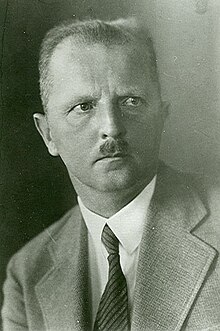Martin Schede
Martin Schede (born October 20, 1883 in Magdeburg , † February 1947 in Gomlitz ) was a German classical archaeologist and from 1937 to 1945 President of the Archaeological Institute of the German Empire .
Life
Schede studied classical archeology, art history and ancient history in Munich, Heidelberg, Berlin and Leipzig. In 1909 he received his doctorate with his dissertation on sima ornamentation, development of the anthem and tendril motif in Leipzig.
From 1910 to 1913 he worked under Theodor Wiegand on the excavations at the Temple of Apollo in Didyma , and since October 1910 also on the Heraion of Samos . In 1919 he became curator and professor at the Berlin museums and, in 1924, succeeded Wiegand as a representative of the Prussian museums in Turkey. The Istanbul Department of the Archaeological Institute of the German Empire emerged from his work in 1929 , and he became its first director. As a result of his work, the research of this institute was not limited to the areas of antiquity, but extended as far as Turkish history. Since 1926 Schede explored the temple of Augustus and the Roma in Ankara with Daniel Krencker . After Wiegand's death, Schede was elected President of the Archaeological Institute of the German Empire in 1937. From 1943 he was an honorary professor at the Friedrich Wilhelms University in Berlin.
Schede was also President of the German Oriental Society (DMG) from 1939 . In 1940 the Aryan paragraph was finally introduced here. He conducted negotiations with the RSHA , the Reich Security Main Office , so that their " Turkestan Working Group ", whose main task was the training of military mullahs for certain SS and Wehrmacht troops , could be affiliated with the DMG. This so-called “Feldmullah” complex belonged to the “Reichsstiftung für Länderkunde”, which the SS operated under different names from the end of 1943. The planned incorporation into the DMG, which was negotiated during 1944 and which Schede had approved according to the SS protocol, was no longer possible due to the war.
Schede had been a member of the NSDAP since June 1, 1937 , but he resisted the ideological appropriation of archaeological research. Schede was taken prisoner by the Soviets at the end of the war and died in the Gomlitz camp.
Fonts (selection)
- Antique eaves molding ornament (= on the history of art abroad 67). Heitz, Strasbourg 1909.
- Athens Castle. Schoetz & Parrhysius, Berlin 1922.
- Greek and Roman sculptures from the Ancient Museum of Constantinople (= masterpieces of the Turkish Museums of Constantinople, vol. 1). de Gruyter, Berlin et al., 1928.
- The ruins of Priene. de Gruyter, Berlin 1934
- with Daniel Krencker: The temple in Ankara. de Gruyter, Berlin 1936
literature
- Robert Volz: Reich manual of the German society . The handbook of personalities in words and pictures. Volume 2: L-Z. Deutscher Wirtschaftsverlag, Berlin 1931, DNB 453960294 , p. 1617.
- Kurt Bittel : Martin Schede †. In: Gnomon 24, 1952, pp. 237-240.
- Kurt Bittel: Martin Schede . In: Reinhard Lullies , Wolfgang Schiering (Hrsg.): Archäologenbildnisse . Portraits and short biographies of classical archaeologists in the German language. von Zabern, Mainz 1988, ISBN 3-8053-0971-6 , pp. 220-221.
Web links
- Literature by and about Martin Schede in the catalog of the German National Library
Individual evidence
- ↑ Birth register StA Magdeburg-Altstadt, No. 3041/1883
- ↑ [1] It had already been decided in 1938, but the registry court had formally criticized the protocol, so it was reformulated and decided again by the general meeting
- ↑ extract S. 348-368, from the Federal Archives A 54, 7 R 920, as well as previous arrangement (in this Engl.). Wilfried Krallert based on Olzschag's report (after 1945) on the question of the SS mullahs. For the dating that can no longer be identified from this extract, position 19430820 (PDF file; 528 kB).
- ^ Ekkehard Ellinger: German Oriental Studies at the time of National Socialism. 1933-1945 (= Thèses. Vol. 4). Deux-Mondes-Verlag, Edingen-Neckarhausen 2006, ISBN 3-932662-11-3 , p. 27.
- ^ Berlin and antiquity. Catalog. Berlin 1979, p. 428.
- ↑ dies in Soviet captivity in Gomlitz camp, ihtp ( memento of the original from September 24, 2015 in the Internet Archive ) Info: The archive link was automatically inserted and not yet checked. Please check the original and archive link according to the instructions and then remove this notice. , [2] . Kurt Bittel's statements "far from his own people, lonely, weakened by hunger and privation" (In: Gnomon 24, 1952, p. 237) and "died as a result of a chain of tragic events" (In: Reinhard Lullies, Wolfgang Schiering ( Ed.): Archäologenbildnisse 1988, p. 221) are very descriptive.
| personal data | |
|---|---|
| SURNAME | Schede, Martin |
| BRIEF DESCRIPTION | German classical archaeologist |
| DATE OF BIRTH | October 20, 1883 |
| PLACE OF BIRTH | Magdeburg |
| DATE OF DEATH | February 1947 |
| Place of death | Gomlitz |
